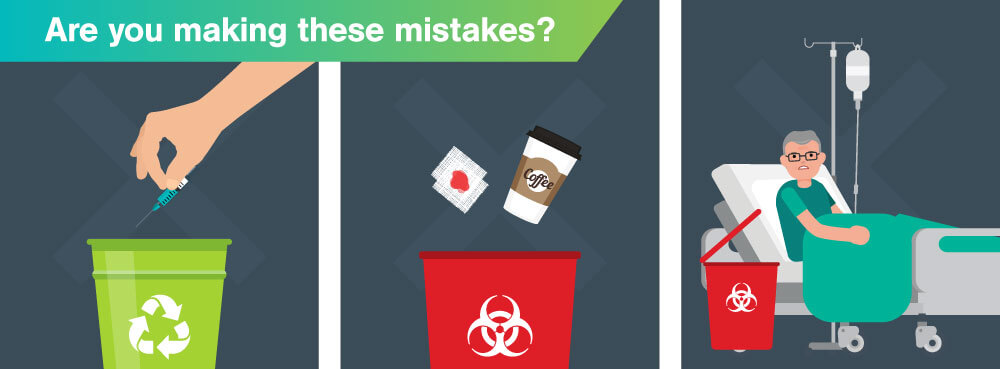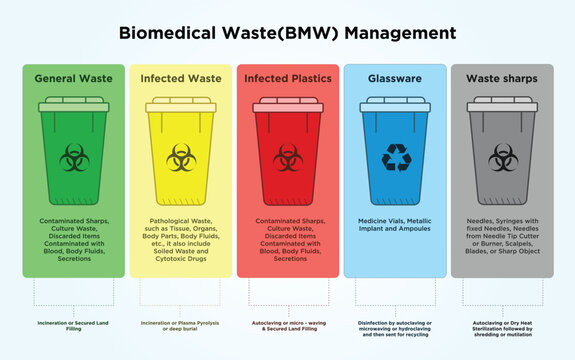Eco-Friendly Solutions for Medical Waste Removal: Prioritizing Safety and Compliance
Wiki Article
Effective Techniques of Medical Garbage Disposal
Reliable methods of medical waste disposal are critical in maintaining public health and environmental security. Clinical waste, consisting of sharps, pathological waste, and pharmaceutical waste, must be dealt with and dealt with appropriately to avoid the spread of infections and secure the environment. This needs adherence to stringent regulations and the implementation of professional waste management practices.Proper partition of clinical waste, secure and secure storage space, reliable therapy and sanitation approaches, and environmentally-friendly disposal alternatives are crucial elements of an efficient clinical garbage disposal system. Expert waste administration services play an important function in guaranteeing compliance with policies and lessening the dangers related to inappropriate disposal. By using these approaches, medical care centers can add to a much safer and cleaner atmosphere while guarding the health of the area.
Correct Partition of Medical Waste
Correct partition of medical waste is necessary for ensuring the secure and effective disposal of these potentially hazardous products. Medical waste refers to any type of waste generated throughout health care activities, such as hospitals, facilities, labs, and research centers. It consists of a vast array of products, such as made use of needles, syringes, contaminated dressings, ran out or unused medications, and organic products.By setting apart medical waste, health care facilities can lessen the threat of infections, injuries, and ecological contamination. The procedure involves classifying waste into various types, such as sharps, contagious waste, pharmaceutical waste, and non-hazardous waste. Each type needs details handling, product packaging, and disposal methods to stop exposure to health care employees, waste management workers, and the basic public.
To make sure correct segregation, health care centers ought to create clear guidelines and offer ample training to staff participants. This consists of educating staff members on the different waste classifications, correct packaging methods, and the usage of proper containers - WasteX Medical Waste Disposal. Additionally, clear signage and color-coding systems can be executed to assist in the recognition and partition of different waste types
Safe and Secure Storage of Medical Waste
Safe and safe storage of medical waste is critical for maintaining the integrity and containment of potentially harmful products. Appropriate storage space not just safeguards health care employees and the general public from exposure to harmful substances but also prevents environmental contamination.To guarantee secure storage, clinical facilities must stick to particular guidelines. Waste ought to be saved in watertight and puncture-resistant containers that are classified properly - medical waste removal service.
Appropriate segregation of clinical waste is likewise important for secure storage. Different kinds of waste, such as sharps, transmittable materials, and pharmaceutical waste, should be divided to stop cross-contamination. This segregation can be achieved via making use of color-coded containers or bins.
Normal monitoring and inspection of the storage space location are crucial to identify any type of possible risks or violations. This consists of checking for signs of damage or damage in the containers, making certain proper air flow, and keeping an eye on temperature and moisture degrees.
Efficient Treatment and Sanitation Approaches

One commonly used therapy approach is autoclaving, which entails subjecting the waste to high-pressure heavy steam at temperature levels over 121 levels Celsius. One more technique is incineration, which involves melting the waste at high temperature levels.
Chemical sanitation is one more effective method for dealing with clinical waste. This method includes using disinfectants such as chlorine substances, phenolic compounds, or hydrogen peroxide to eliminate or inactivate pathogens (WasteX Medical Waste Disposal). Chemical sanitation is commonly used for fluid waste, such as lab examples or bodily liquids
In the last few years, different treatment approaches such as microwave disinfection, irradiation, and organic treatment have actually likewise gained interest. These methods supply advantages such as lowered environmental influence and energy intake compared to standard methods.
Environmentally-friendly Disposal Options
In the realm of medical garbage disposal, considering environmentally-friendly alternatives is vital. Healthcare centers produce a significant quantity of waste, including transmittable his response materials, drugs, and chemicals, which can pose significant dangers to human health and the atmosphere if not taken care of appropriately. There are numerous environmentally-friendly disposal choices readily available that can assist mitigate these dangers.
One such option is reusing. Recycling clinical waste involves setting apart and processing specific products for reuse or repurposing. For example, plastics, glass, and steel containers can be reused, decreasing the need for brand-new materials and lessening the amount of waste sent to land fills. Additionally, some medical care facilities have carried out reusing programs for sure medical gadgets or devices, more reducing waste generation.
One more environmentally-friendly disposal choice is waste-to-energy conversion. This technique involves transforming clinical waste into power through processes like incineration or anaerobic digestion. medical waste disposal. Incineration, when done appropriately with sophisticated innovations, can create energy while minimizing hazardous emissions. Anaerobic digestion, on the various other hand, breaks down natural waste in the absence of oxygen, producing biogas that can be used for electricity or heat generation.

Benefits of Expert Waste Administration Solutions
One considerable advantage of professional waste management services is the improved effectiveness in disposing and dealing with of medical waste. By using specialist waste monitoring solutions, medical care centers can make sure that all medical waste is managed and disposed of correctly, lessening the danger of contamination and the spread of illness.Professional waste monitoring solutions utilize skilled and trained personnel that are knowledgeable concerning the regulations and standards for clinical waste disposal. They have access to specialized devices and devices that allow them to take care of various kinds of clinical waste securely and effectively. These services likewise have reputable treatments and procedures in location to ensure that waste is set apart, packaged, transferred, and disposed of in conformity with regional, state, and federal regulations.
In addition, expert waste administration solutions can offer health care facilities with comprehensive waste management solutions. They can supply services such as waste collection, transport, disposal, and therapy, customized to the details demands and needs of the facility. This eliminates the worry of taking care of waste internally, permitting health care team to concentrate on giving top quality client treatment.
Verdict
In conclusion, reliable techniques of medical waste disposal entail correct segregation, safe storage, therapy and disinfection, and environmentally-friendly disposal alternatives. These methods ensure the secure handling and monitoring of medical waste, protecting against the spread of infections and securing the setting.Clinical waste, consisting of sharps, pathological waste, and pharmaceutical waste, must be dealt with and disposed of appropriately to prevent the spread of infections and shield the setting.Proper segregation of medical waste, safe and protected storage space, effective treatment and sanitation approaches, and environmentally-friendly disposal options are crucial components of a reliable medical waste disposal system. The procedure includes classifying waste right into different kinds, such as sharps, contagious waste, pharmaceutical waste, and non-hazardous waste. By making use of specialist waste administration services, healthcare facilities can ensure that all medical waste is managed and disposed of properly, lessening the risk of contamination and the spread of diseases.
Specialist waste management solutions utilize trained and experienced workers who are experienced about the laws and standards for clinical waste disposal.
Report this wiki page